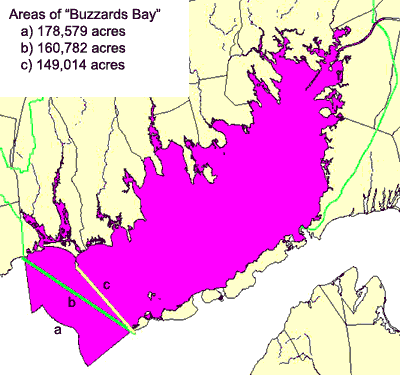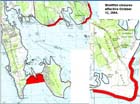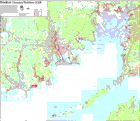Shellfish Bed Closures from the Bouchard Oil Spill
Related Pages: Shellfishing Info | Shellfish Opening Success Stories | Current Shellfish Bed Closures
Note: Much of the information on this page was based on data kindly provided by the Massachusetts Division of Marine Fisheries.
Closure Summary Information
This page consists of summary information on the 2003 Bouchard oil spill prepared by the Buzzards Bay NEP based on our own independent calculations. The maps below, and the reported acreage closed are approximate, and do not include bans due to bacterial contamination. Most closed areas relating to the Bouchard No. 120 were rescinded by October 15, 2004. On that date, the Massachusetts Division of Marine Fisheries rescinded all closures, except for for small portions of the Mattapoisett, Fairhaven, and Dartmouth. [Click this link to read DMF’s 10/15/2004 Announcement.] These areas, totaling approximately 273 acres, remained closed through April 2007. By May 2009, DMF reported to us that 135 acres of shellfish beds remained closed that were related to the oil spill (129 acres in Fairhaven and 6 acres in Mattapoisett at Leisure Shores), although we have seen other agencies and press articles quote different estimates. As of May 25, 2011, a small area (3.7 acres) just south of Long Island (Causeway Road) remained closed because of oil contamination. the closure description: “That portion of BB:17 in the Town of Fairhaven north of a line drawn from the “NO SHELLFISHING” sign on the beach at 3 Nakata Avenue on Sconticut Neck to the “NO SHELLFISHING” sign on the beach at the western end of Fishermen Road on West Island; and, south of the Goulart Memorial Drive.”
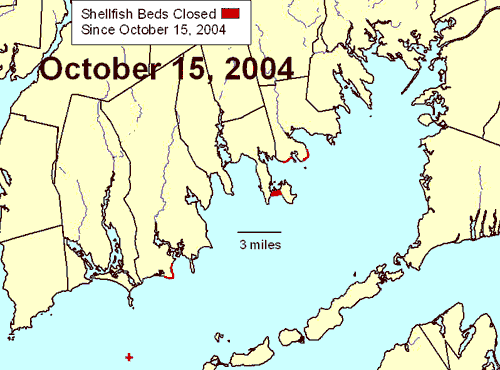
In the past, oil related shellfish bans fell into two categories. First, the state adopted a policy that shellfish beds within 100 yards of any beach segment that had not passed IRA oil cleanup inspections, or certain larger areas of these beaches would remain closed. Second, shellfish resource areas where shellfish showed elevated concentrations of hydrocarbons also remained closed. We believe that most areas remaining closed fell into the first category, however contamination levels in shellfish have not been made public.
The rescission of an oil ban in an area means that shellfish resource area will open unless they are closed to shellfishing because of other pollution sources, principally elevated bacteria concentrations.
While only a small percent of the bay has remained closed in 2004 because of an oil spill ban, some towns have been more affected than others. Acreage statistics do not fully communicate the impact of these closures, because areas with the 100-yard ban from shore, effectively limit shellfishing operations in those stretches of coastline because harvesting most often occurs very close to shore. Most residents shellfish along this nearshore intertidal and subtidal area because of access and the effective depth limit of collection by wading or using small boats. To show the degree of perceived shoreline closures, we have graph both the percent of the bays area and percent of the coastline in Buzzards Bay with an immediate shellfish bed oil ban along the shore. For example, in the first half of 2004, only 2.4% percent of the bay area was closed, but nearly 10% of the coastline was affected. (our percent estimates may differ from some other estimates. Click here to jump to a possible explanation.]
However, a large portion of the coastline affected in the first half of 2004 was located on the remote Naushon Island where there is little shellfishing. These areas are now open. Today only one half of one percent of the area of the bay is closed, but this represents three percent of the coastline.
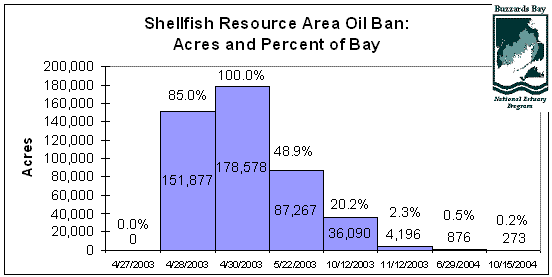
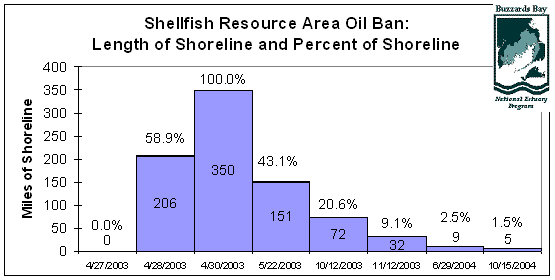
Note: Data does not include Rhode Island closures or coastline. October 2004 closures in still in effect as of April 2007.

The acres graph above showing a actual time-span x-axis versus a normal or logarithmic y-axis.
Summary of Bouchard No. 120 Oil closures
On April 28 2003, the lower two-thirds (Nyes Neck, Falmouth to Angelicas Point, Mattapoisett and south) of Buzzards Bay were closed because of the Bouchard No. 120 oil spill. When oil slicks and tar balls entered the upper third of the bay, the remainder of Buzzards Bay was closed on April 30.
On Thursday May 22, unoiled and very lightly oiled areas were reopened to shellfishing based on shoreline evaluations of oiling and PAHs (Poly-Aromatic Hydrocarbons) levels evaluated in shellfish samples. Based on new shellfish tissue data and beach cleanup progress, the Division of Marine Fisheries reopened additional areas of Buzzards Bay on October 12, 2003 (announcement released October 10), and November 12, 2003 (announcement released November 10). These closures were further reduced in June 2004. The last oil spill change status occurred in October 2004, when only 4 areas remained closed.
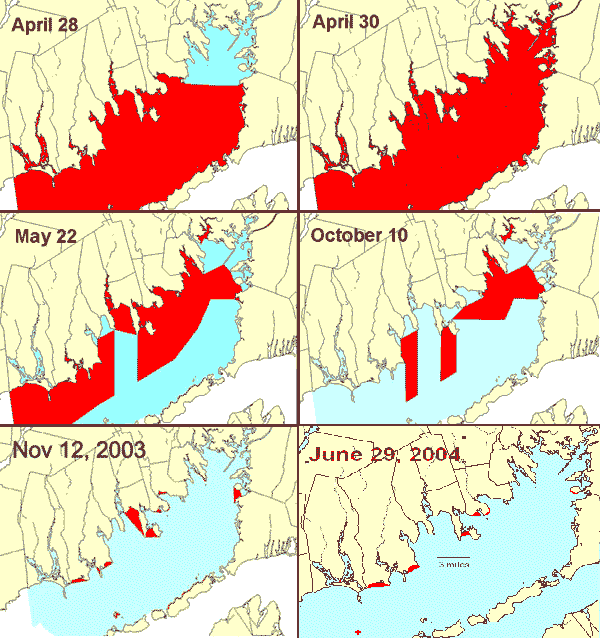
Changes in Shellfish Resource Areas closed (red areas) closed as a result of oiling.
DMF Notices
DMF’s 10/15/2004 Announcement reducing closures to just four sites.
DMF’s 6/29/2004 shellfish oil ban rescission announcement.
DMF’s November 10, 2003 shellfish oil ban rescission announcement for Marion
DMF’s November 10, 2003 shellfish oil ban rescission announcement for Wareham
DMF’s November 10, 2003 shellfish oil ban rescission announcement for Buzzards Bay towns, except Marion and Wareham
DMF’s October 3, 2003 shellfish oil ban rescission announcement
Oil impacts to shellfish beds
Buzzards Bay is rich in shellfish resources and has a $4 million shellfish industry, 25% of Massachusetts’ total. Species caught include soft-shelled clams, quahogs, scallops, oysters, and lobster around Buzzards Bay. More than 500 commercial permits and more than 12,800 recreational permits are sold annually among communities, and shellfishing is a popular pastime for many tourists.
Oil spills have previously affected shellfish beds in Buzzards Bay. For example, the State closed shellfish beds in Wild Harbor for at least 6 years because of the barge Florida spill in 1969. The Town of Falmouth closed a portion of the inner harbor far longer, possibly to 20 years, because shellfish were tainted with petroleum.
In general, shellfish are not expected to be adversely affected by the oil. The exception may be soft shell clams, which are intertidal, and may experience mortality in heavily oiled areas. Some dead surf clams were found at Barneys Joy in Dartmouth because of heavy oiling there.
Where shellfish are not killed by acute toxicity, the primary concern with this oil spill is that the meat may taste oil tainted, or elevated hydrocarbons from the oil may pose a human health risk if consumed. For this reason, the Massachusetts Division of Marine Fisheries and MA Department of Public Health will test shellfish and only allow future beds to be opened when it is determined the shellfish are safe for consumption.
Where are the shellfish beds?
Nearly every harbor in Buzzards Bay has some good shellfish beds. Most shellfishing occurs very close to shore, particularly in the harbors. There is also some dredging for shellfish, mostly quahogs, in deeper waters offshore.
Go to our Shellfishing Information page to see a map of Buzzards Bay shellfish resources.
We prepared this shellfish map which showed areas with practical densities of shellfish for commercial and recreational harvest. This map was developed by the Massachusetts Division of Marine Fisheries (DMF) prior to the Bouchard oil spill, and converted into GIS coverages by the Massachusetts Office of Coastal Zone Management.
Where are the bacterial closures?
Many areas of Buzzards Bay have been closed to shellfish due to bacterial closures. Some of these closures are permanent (year-round), seasonal (summertime), or rainfall conditioned. For example, the closures at the end of Clarks Point in New Bedford, and East of Mishaum Point in Dartmouth are permanent closures because of municipal sewage treatment facility discharges in those areas. Other areas like Sippican Harbor in Marion and West Falmouth Harbor in Falmouth are closed because of elevated bacteria levels or high densities of boats moored during the summer. Most closures around Buzzards Bay are the result of “non-point” land based sources, often conveyed by stormwater runoff.
When the Bouchard No. 120 oil contamination closures are removed, any pre-existing bacteria closures will remain in effect. Go to our Current closures of shellfish in Buzzards Bay for more information.
Discrepancies in reported acreages closed
The maps and calculations reported here are approximate, and based on calculations by the Buzzards Bay NEP. There are several possibilities that could account for the discrepancy between our current estimate of acreages closed and those reported elsewhere. One possibility is that we may have omitted some closed areas in the November 10 map above. Another contributing factor could have been that our percent closed calculation was based on a different total acreage of Buzzards Bay. Our shellfish resource area acreage for Buzzards Bay includes all Massachusetts waters to the Rhode Island border, which technically includes a portion of Rhode Island Sound, and even a portion of the Cape Cod Canal because it is in our watershed boundary. This definition of “Buzzards Bay” totals 178,579 acres, and includes all the areas in magenta on the map below. The jurisdictional boundary for the Buzzards Bay NEP is the green line (b) on the map from the RI border to Cuttyhunk, and this definition of Buzzards Bay covers 160,782 acres. Finally, the “real” boundary of Buzzards Bay based on nautical charts is a yellow line on the map below (c) drawn from Gooseberry Point to Cuttyhunk Island. This totals 149,014 acres. Even the lowest total does not account for the reported percent of the bay closed differences.
